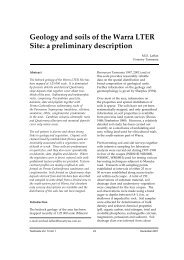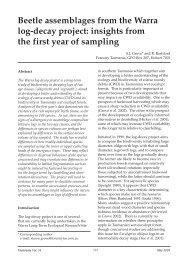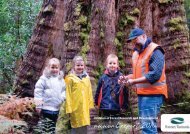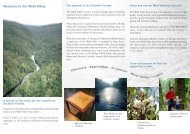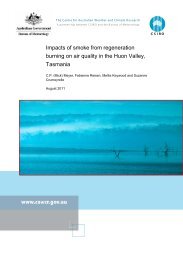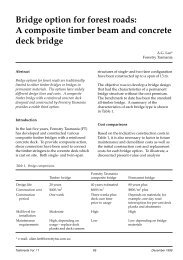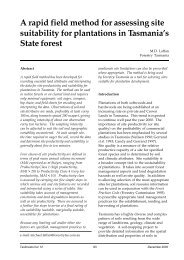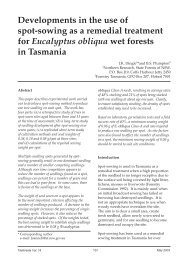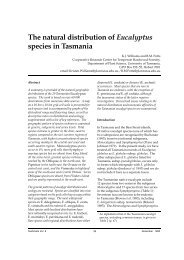sustainable forest management - Forestry Tasmania
sustainable forest management - Forestry Tasmania
sustainable forest management - Forestry Tasmania
You also want an ePaper? Increase the reach of your titles
YUMPU automatically turns print PDFs into web optimized ePapers that Google loves.
<strong>forest</strong>s now and into the future<br />
Productive capacity<br />
Productive capacity is one way to measure the economic<br />
and long-term sustainability of <strong>forest</strong>s. To maintain and<br />
enhance the productive capacity of <strong>Tasmania</strong>’s state <strong>forest</strong>s,<br />
<strong>Forestry</strong> <strong>Tasmania</strong> models and monitors <strong>sustainable</strong> yield<br />
to ensure that harvesting and use of wood products is<br />
consistent with the long-term productive capacity of<br />
<strong>Tasmania</strong>’s state <strong>forest</strong>s. <strong>Forestry</strong> <strong>Tasmania</strong> maintains<br />
productive capacity through yield regulation of its native<br />
<strong>forest</strong> and plantation resource and assesses the <strong>sustainable</strong><br />
yields for both. More detailed trend data for this section can<br />
be found in Appendix one.<br />
Sustaining timber production<br />
For <strong>Forestry</strong> <strong>Tasmania</strong> to maintain the ongoing supply of<br />
timber an effective area of production <strong>forest</strong> is required.<br />
Figure 6 provides an overview of the six components<br />
that make up the total <strong>forest</strong> estate and shows that<br />
approximately 46 per cent of this area is used for wood<br />
production. Native <strong>forest</strong> production areas make up<br />
39 per cent of the area and plantations seven per cent.<br />
The remaining area (54 per cent) is included in formal<br />
and informal reserves and other native <strong>forest</strong> outside<br />
production areas. Since 2000/01, the area available in<br />
native <strong>forest</strong> production areas has reduced by 16 per cent<br />
or 116,300 hectares.<br />
The majority of the decrease in the available native <strong>forest</strong><br />
over the past six years has been as a result of additional<br />
reserves being implemented under the <strong>Tasmania</strong>n<br />
Community Forest Agreement. However, the conversion of<br />
a portion of native <strong>forest</strong> to plantation has also contributed.<br />
Figure 6. State <strong>forest</strong> classification from 2003/04 to 2007/08<br />
Area (ha)<br />
800,000<br />
700,000<br />
600,000<br />
500,000<br />
400,000<br />
300,000<br />
200,000<br />
100,000<br />
0<br />
Native <strong>forest</strong><br />
production<br />
areas<br />
Native <strong>forest</strong><br />
outside<br />
production<br />
areas<br />
Ongoing losses also occur due to areas being removed from<br />
wood production during pre-harvest planning to protect<br />
conservation values.<br />
A vital prerequisite for <strong>sustainable</strong> <strong>forest</strong> <strong>management</strong> is<br />
that the volume of timber harvested from the <strong>forest</strong> estate<br />
does not exceed its productive and regenerative potential<br />
over a given time period. <strong>Forestry</strong> <strong>Tasmania</strong> manages<br />
harvesting in state <strong>forest</strong>s to ensure an ongoing supply of<br />
at least 300,000 m 3 per year of high quality eucalypt sawlog<br />
required by the <strong>Forestry</strong> Act. The availability of at least<br />
300,000 m 3 per year of high quality eucalypt sawlog is also<br />
recognised in Clause 77 of the Regional Forest Agreement.<br />
Informal<br />
Reserves<br />
Forest<br />
Reserves<br />
Softwood<br />
Plantation<br />
Hardwood<br />
Plantation<br />
2003/04 2004/05 2005/06 2006/07 2007/08<br />
In 2007/08 a total of 304,000 m 3 of high quality sawlog<br />
and veneer was produced (Figure 7). The five-year average<br />
sawlog yield remained within the sustained yield strategy,<br />
while average pulpwood yield was below the indicative<br />
long-term supply level of 2.8 million tonnes (Figure 8).<br />
Figures 7 and 8 highlight the differing sawlog/pulpwood<br />
ratios in the <strong>forest</strong> that are harvested each year.<br />
19




